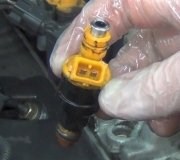Dandy. First of all, there had better not be 12 volts to the fuel pump unless the engine is rotating, (cranking or running). That is a safety system built into all models. If you're going to check for voltage to the fuel pump, you have to watch during that one second when a helper turns on the ignition switch. A test light works best for this because digital voltmeters don't respond fast enough. You also can usually see the light when working on the car by yourself.
When you find the fuel pump runs for that first one second, but not again during cranking, it is almost always due to a failure of the crankshaft position sensor or the camshaft position sensor, however, there also will be no spark. Since you do have spark, we can leave that part of the story for another day.
Next, if you do hear the hum for one second, but it's not pumping gas, you most likely don't have enough gas in the tank. The pump sits in a bowl so the gas doesn't run away from the pickup screen when going around corners with a low fuel level. Once the engine is running, that bowl is kept full by the gas returning from the fuel pressure regulator on the engine. When you reassemble everything and the tank is empty, you need to get some gas in that bowl so the pump has something to pump. In the case of my '88 Grand Caravan, the filler pipe dumped the gas right into that bowl. I only needed a quart of gas to get the engine started. It's a different story with my '94 Grand Voyager. The incoming gas misses the bowl and goes into the rest of the tank. I have to put in at least five gallons before the level gets high enough to overflow into the bowl. After that, it can be run down to empty, like normal.
As soon as you start talking about repeat fuel pump failures, we have to discuss a problem that was pretty common ten to 20 years ago. Chrysler fuel pumps are built to very tight clearances to make them quieter than those on other car brands, but that makes them susceptible to locking up from microscopic debris in the gas tank. My suspicion is that debris is mold that feeds on the alcohol in today's gas. We don't hear about that much anymore, probably due to the better additives we have in gas now. The story used to be you'd install three to five replacement fuel pumps, and each one would fail within a few weeks. Finally, out of frustration, you buy one from the dealer's parts department and have no more problems.
The dealer's pump wasn't actually the solution. It was simply each new pump had collected some of that debris, so by the time the dealer's pump was installed, it was all gone. Any replacement pump would have worked. The service bulletin for this problem recommended the gas tank be sent to a radiator repair shop to have it steam-cleaned, then the new pump could be installed.
Another problem with a very elusive solution to keep in mind has to do with the strainer, or "sock" on the bottom of the fuel pump housing. I've had those plug up four times, two on older carbureted cars, and twice on my '88 Grand Caravan. One of the clues is the engine runs fine at highway speed and when accelerating, but tends to stall when the highest volume of fuel is being pumped, which is during coasting. This is the opposite of how it acts with a carbureted engine. Those run okay when the lowest amount of fuel is being used, which is at idle.
The socks cost $3.00 for my older cars, and $12.00 for my '88 Caravan. It was a simple clip-on item. The sock is not available separately for my '94 model, and has never caused a problem, ... Yet. The only way to get a new one is to buy the entire fuel pump housing assembly. I don't see a separate strainer listed for your model either, so to get a new one, you have to replace the housing. A lot of us install a replacement pump and motor into the old housing. That leaves the old strainer in there.
Don't even look at the fuel pressure regulator. Those have caused a lot of trouble due to leaking into the engines on older GM trucks, but not on other brands. In ten years at the dealership, I only ran into two problems, and both were due to the small rubber O-ring on their nozzles. One was cut on a brand new car that was just delivered. One was on a customer's car. The O-ring was cut during a previous service but they didn't want to spend the $0.35 for a new one. Both engines ran fine once started, but they lost fuel pressure as soon as the engine was stopped, then they had very long crank times at the next startup. That pressure is supposed to hold for weeks without bleeding down.
If you do find there is never 12 volts to the fuel pump, I'll find the wiring diagram, then we'll figure out where to look next.
Wednesday, April 5th, 2023 AT 5:56 PM


